Fantasy Books
The Twisted Ones - Book Review
 The Twisted Onesby T. Kingfisher
The Twisted Onesby T. KingfisherWhat is it about:When a young woman clears out her deceased grandmother’s home in rural North Carolina, she finds long-hidden secrets about a strange colony of beings in the woods.
When Mouse’s dad asks her to clean out her dead grandmother's house, she says yes. After all, how bad could it be?
Answer: pretty bad. Grandma was a hoarder, and her house is stuffed with useless rubbish. That would be horrific enough, but there’s more—Mouse stumbles across her step-grandfather’s journal, which at first seems to be filled with nonsensical rants…until Mouse encounters some of the terrifying things he described for herself.
Alone in the woods with her dog, Mouse finds herself face to face with a series of impossible terrors—because sometimes the things that go bump in the night are real, and they’re looking for you. And if she doesn’t face them head on, she might not survive to tell the tale.
What did I think of it:This is yet another really cool horror!
As always Kingfisher managed to creep me out even before anything really scary or creepy happened. I really liked Mouse and her dog, and even though in the first few pages you discover that Mouse is telling the story after the fact, I worried about the two of them.
The building tension and atmosphere is once again so good! It kept me glued to the pages to find out what would happen next. I'm impressed how Kingfisher can write dark atmosphere and manage to have the story be funny at times as well, I must say.
Note: This story is inspired by The White People by Arthur Machen, which I definitely plan to read to see where the stories connect.
All in all another one for my keeper shelves. We'll try one of Kingfisher's more romantic books next.
Why should you read it:It's a humorous and suspenseful horror read
Archangel’s Ascension – Nalini Singh
 Archangel's Ascension Series: Guild Hunter #17
Archangel's Ascension Series: Guild Hunter #17 Published by Penguin on May 6, 2025
New York Times bestselling author Nalini Singh takes us back to her breathtakingly passionate Guild Hunter World, where an impending transformation will be both an ending and a beginning…
Aodhan and Illium. Adi and Blue. Sparkle and Bluebell. Friends become lovers, their future a wild unknown.
Finally reunited in New York, they must now learn to navigate the monumental shift in their relationship. But for these two members of Archangel Raphael’s legendary Seven, there is no time to rest. As they investigate a case for the Tower that echoes the darkness from Aodhan’s past, they will be forced to confront not only the scars that mark them both, but the promise of a vast power that flickers in Illium.
The threat of ascension has haunted and troubled Aodhan’s Blue for too long, the forces of change immutable and without mercy...and uncaring of Illium’s fierce wish to remain part of the Seven. Change is a constant in an immortal’s life, and this new horizon will bring with it both terrible heartbreak and a joy extraordinary enough to reverberate through time…
Pages: 416Genres: Fiction / Fantasy / Paranormal, Fiction / Fantasy / Urban, Fiction / Romance / Paranormal / Vampires
Format: eARC, eBook
by Nalini Singh
ISBN: 9780593550045
Also in this series: Archangel's Shadows (Guild Hunter, #7), Archangel's Enigma (Guild Hunter, #8), Archangel's Heart (Guild Hunter, #9), Archangel's Viper (Guild Hunter, #10), Archangel's Prophecy, Archangel's War
Also by this author: Shards of Hope, Archangel's Shadows (Guild Hunter, #7), Archangel's Enigma (Guild Hunter, #8), Rock Redemption, Allegiance of Honor (Psy-Changeling, #15), Rock Wedding (Rock Kiss, #4), Secrets at Midnight (Psy-Changeling #12.5)
{ "@context":"https://schema.org", "@type":"Review", "datePublished": "2025-05-06T14:41:12+00:00", "description": "\n\u00a0\n\u00a0\n\u00a0\nThe latest installment in the Guild Hunter Series offers an engaging read, yet it falls short of the high standards typically associated with Nalini Singh. The narrative frequently shif", "publisher": { "@type": "Organization", "name": "Books In Brogan" }, "url": "https:\/\/booksinbrogan.com\/blog\/2025\/05\/06\/archangels-ascension-nalini-singh\/", "itemReviewed": { "@type": "Book", "name": "Archangel's Ascension", "author": { "@type": "Person", "name": "Nalini Singh", "sameAs": "" }, "isbn": "9780593550045" }, "author": { "@type": "Person", "name": "Books In Brogan", "sameAs": "https:\/\/booksinbrogan.com\/" }, "reviewRating": { "@type": "Rating", "ratingValue": false, "bestRating": "5" } }
The latest installment in the Guild Hunter Series offers an engaging read, yet it falls short of the high standards typically associated with Nalini Singh. The narrative frequently shifts between the present and the future, which can be disorienting as it requires readers to recall events from previous books while trying to follow the current storyline. A more cohesive approach that focused solely on the future timeline would have enhanced my enjoyment of the book.
Tuesday Musings: Our Child’s Birthday
 Our beloved older daughter would have been thirty years old today.
Our beloved older daughter would have been thirty years old today.
Alexis Jordan Berner-Coe. Early on, it felt like a big name for such a tiny child. She was always the smallest in her class, the smallest on her team, the smallest in her dance recitals. We called her Alex. The head counselor at her first summer soccer camp called her “ABC” — for Alex Berner-Coe. The name stuck.
 Later we realized that the name was too small to contain her, too simple to encompass all that she was, all that she would grow to be. She might have been the smallest in her class, but she was smart as hell and personable, with a huge, charismatic personality. She might have been the smallest on her teams, but she was fast and savvy and utterly fearless. On the soccer pitch and in the swimming pool, she was fierce and hard-working. Size didn’t matter. She might have been the smallest on stage, but she danced with passion and joy and grace, and, when appropriate, with a smile that blazed like burning magnesium.
Later we realized that the name was too small to contain her, too simple to encompass all that she was, all that she would grow to be. She might have been the smallest in her class, but she was smart as hell and personable, with a huge, charismatic personality. She might have been the smallest on her teams, but she was fast and savvy and utterly fearless. On the soccer pitch and in the swimming pool, she was fierce and hard-working. Size didn’t matter. She might have been the smallest on stage, but she danced with passion and joy and grace, and, when appropriate, with a smile that blazed like burning magnesium.
 One time, in a soccer match against a hated rival, a player from the other team, a huge athlete nearly twice Alex’s size, grew tired of watching Alex’s back as she sped down the touchline on another break. So she fouled Alex. Hard. Slammed into her and sent her tumbling to the ground. I didn’t have time to worry about my kid. Because Alex bounced up while the ref’s whistle was still sounding, and wagged a finger at the girl. “Oh, no you don’t,” that finger-wag said. “You can’t intimidate me.”
One time, in a soccer match against a hated rival, a player from the other team, a huge athlete nearly twice Alex’s size, grew tired of watching Alex’s back as she sped down the touchline on another break. So she fouled Alex. Hard. Slammed into her and sent her tumbling to the ground. I didn’t have time to worry about my kid. Because Alex bounced up while the ref’s whistle was still sounding, and wagged a finger at the girl. “Oh, no you don’t,” that finger-wag said. “You can’t intimidate me.”
When she was in eighth grade, she decided to try out for the annual dance program at the university where Nancy worked. The program was called Perpetual Motion, and it was almost entirely student run. Each dance was choreographed by a student or group of students. They decided who they wanted in their dances and who they didn’t. The men and women in the program could easily have dismissed this thirteen-year-old as too young, too inexperienced, not really a part of the college. But instead, to their credit, they judged her on her dancing and maturity. She appeared in Perpetual Motion every year from eighth grade through twelfth, and we saw pretty much every performance. Not once did Alex ever seem out of place or beyond her depth.
 She was effortlessly cool, like her uncle Bill — my oldest brother. And she had a wicked sense of humor. She was brilliant and beautiful. She loved to travel. She loved music and film and literature. She was passionate in her commitment to social justice. She adored her younger sister. And she was without a doubt the most courageous soul I have ever known.
She was effortlessly cool, like her uncle Bill — my oldest brother. And she had a wicked sense of humor. She was brilliant and beautiful. She loved to travel. She loved music and film and literature. She was passionate in her commitment to social justice. She adored her younger sister. And she was without a doubt the most courageous soul I have ever known.
 When Alex was three years old, Nancy took a sabbatical semester in Quebec City, at the Université Laval. I stayed in Tennessee, where I was overseeing the construction of what would become our first home. Once Nancy found a place for them to live, I brought Alex up to her and helped the two of them settle in. In part, that meant finding a day-school for Alex so that Nancy could conduct her research. We put her in a Montessori school that seemed very nice, but was entirely French-speaking. The first morning, Alex was in tears, scared of a place she didn’t know, among people she could scarcely understand. But we knew she would love it eventually, and as young parents, we had decided this was best. So we explained to her as best we could that we would be back in a few hours, that the people there would take good care of her, and that this was something we needed for her to do. I will never forget walking away from the school, with tiny Alex standing at the window, tears streaming down her face as she waved goodbye to us. And I remember thinking then, “She is the bravest person I know.” Remember, Alex, all of three years old, didn’t speak a word of French!!
When Alex was three years old, Nancy took a sabbatical semester in Quebec City, at the Université Laval. I stayed in Tennessee, where I was overseeing the construction of what would become our first home. Once Nancy found a place for them to live, I brought Alex up to her and helped the two of them settle in. In part, that meant finding a day-school for Alex so that Nancy could conduct her research. We put her in a Montessori school that seemed very nice, but was entirely French-speaking. The first morning, Alex was in tears, scared of a place she didn’t know, among people she could scarcely understand. But we knew she would love it eventually, and as young parents, we had decided this was best. So we explained to her as best we could that we would be back in a few hours, that the people there would take good care of her, and that this was something we needed for her to do. I will never forget walking away from the school, with tiny Alex standing at the window, tears streaming down her face as she waved goodbye to us. And I remember thinking then, “She is the bravest person I know.” Remember, Alex, all of three years old, didn’t speak a word of French!!
Needless to say, when we returned that afternoon to take her home, she was having the time of her life. She’d already made a bunch of friends. She’d already charmed her two teachers. And, I kid you not, she had already picked up several French phrases, which she spoke with a perfect Quebecois accent.
 Her dauntlessness served her well on the pitch and in the pool, on stage and in the classroom. It fed an adventuresome spirit that took her to Costa Rica for a semester in high school, to the top of Mount Rainier with a summer outdoor program, to a successful four years at NYU, to Germany for part of her sophomore year in college, to Spain for all of her junior year in college, and on countless side-trips all over Europe.
Her dauntlessness served her well on the pitch and in the pool, on stage and in the classroom. It fed an adventuresome spirit that took her to Costa Rica for a semester in high school, to the top of Mount Rainier with a summer outdoor program, to a successful four years at NYU, to Germany for part of her sophomore year in college, to Spain for all of her junior year in college, and on countless side-trips all over Europe.
And it allowed her to face the cancer that would eventually claim her life with remarkable strength, equanimity, and grace. She knew from the time of her diagnosis — a rare form of cervical cancer already at Stage 4 — that she faced long odds. I know that in private moments, and with her closest friends, she grieved for all that the disease would take from her. But she never allowed cancer to control her. She continued to work, to see friends and family, to travel, to go to movies and concerts and parties. She took classes. While undergoing chemo treatments, she turned her need for headscarves into a fashion statement. She lived her final years on her terms, refusing to wallow in self-pity because to do so would have meant sacrificing the joy for living that defined her.
 She was, in short, remarkable. I loved her more than I can possibly say. I also admired her deeply. To this day, I push myself to do things that might make me uncomfortable or afraid by telling myself, “Alex would do it, and she’d want me to do it as well.”
She was, in short, remarkable. I loved her more than I can possibly say. I also admired her deeply. To this day, I push myself to do things that might make me uncomfortable or afraid by telling myself, “Alex would do it, and she’d want me to do it as well.”
She had twenty-eight and a half years, which wasn’t nearly enough. She did amazing things in that short time and could have done — should have been able to do — so very much more.
I miss her and think about her every minute of every day.
Happy birthday, my darling child. I love you to the moon and back.

Teaser Tuesdays - I Got Abducted by Aliens and Now I'm Trapped in a Rom-Com
 "Thicken Nugget, you evil bitch, stop murdering half the desert," I muttered from behind my camera. As expected, Thicken Nugget ignored my request.
"Thicken Nugget, you evil bitch, stop murdering half the desert," I muttered from behind my camera. As expected, Thicken Nugget ignored my request.(page 1, I Got Abducted by Aliens and Now I'm Trapped in a Rom-Com by Kimberly Lemming)
---------
Teaser Tuesdays is a weekly bookish meme, previously hosted by MizB of Should Be Reading. Anyone can play along! Just do the following: - Grab your current read - Open to a random page - Share two (2) “teaser” sentences from somewhere on that page BE CAREFUL NOT TO INCLUDE SPOILERS! (make sure that what you share doesn’t give too much away! You don’t want to ruin the book for others!) - Share the title & author, too, so that other TT participants can add the book to their TBR Lists if they like your teasers!
Book review: Dunstan the Wanderer by Raymond St. Elmo

Book links: Amazon, Goodreads
ABOUT THE AUTHOR: Raymond St. Elmo is a programmer of artificial intelligences and virtual realities, who has no time for literary fabrications of fictitious characters and world-building. And yes, that was meant to be ironic.
A degree in Spanish Literature gave him a love of Magic Realism. Programming gave him a job. The job introduced him to artifical intelligence and virtual realities; as close to magic as reality is likely to get outside the covers of a book. And yes, that was meant to be cynical.
The author of several first-person comic-accounts of strange quests for mysterious manuscripts, mysterious girls in cloaks whose face appears SUDDENLY IN THE FLASH OF LIGHTNING. And yes, that was meant to be dramatic.
Publisher: St. Elmo Labs (April 14, 2025) Length: 414 pages Formats: ebook, paperback
Dunstan The Wanderer is an oddball fantasy-romance-adventure that opens in the dusty corners of reality and ends somewhere just shy of Hell. Quite literally. It's the story of a lonely, book-obsessed man whose best friend is an imaginary ten-year-old and whose idea of a good time involves cataloging ancient manuscripts. He’s not unhappy, mind. Dunstan’s the kind of person who lives mostly in his head, buried in books and scrolls, happy to spend quality time with himself. He’s got a quiet life he appreciates. And then, everything changes.
He meets a girl. There's a portal. And then there's Hell.
If you like your fantasy whimsical yet sincere, romantic but not saccharine, this book will scratch the itch. The love it depicts is far from cliche - Dunstan and Kath chase each other across worlds while dodging unhinged gods, interdimensional bureaucracy, and their own madness. Sometimes you'll wonder if they need therapy or an exorcist more. Anyway, it's part love story, part fever dream. The world building has a dreamlike feel. Additionally, grown-up versions of characters chime in from time to time to judge their past selves, and I enjoyed their comments. Basically, it's a fairytale for adults who like footnotes, metafiction, and existential dread seasoned with hope.
There’s a lot going on. Possibly too much at times. St. Elmo’s writing is sharp, strange, and packed with more clever turns of phrase than strictly necessary. Sometimes you simply have to reread a paragraph five times to figure out what’s happening. But when it hits (and it often does), it really hits.
There were moments that made me smile, sigh, roll my eyes, but also yawn. Dunstan himself is a charming protagonist, the kind of introvert who retreats into books not out of misery but out of contentment. Watching him get dragged - emotionally and literally - out of his comfort zone is part of the book’s appeal.
This is the third installment in the Wanderers series, but it works perfectly well as a standalone. Fans of the previous books will enjoy seeing familiar characters return, though newcomers can jump in here and still catch the full ride to the gates of hell and back. Bonus points for acknowledging that love isn’t just star-crossed passion - it’s arguing over groceries, garden pests, and who gets the last word.
Smart, strange, and romantic in the most chaotic way. A bit wordy, yes, but well worth the detour through the Inferno.
Oof. Yet Another WorldCon Controversy

Good afterevenmorn, Readers!
I have been out of the writing world loop for a bit, being wrapped up in my own personal stuff (it’s a terrible combination of absolutely no time whatsoever, “out of sight, out of mind,” and having my head in the clouds as I’m neck deep in the first draft of a book), so I’m quite late to the party. Apparently, World Con has once again landed itself in some controversy.
Let me fill you in if you are like I was just two days ago; utterly clueless about it all.
 Image by Robert Fotograf from Pixabay
Image by Robert Fotograf from Pixabay
It appears that Worldcon 2025, which will be held in August in the fine city of Seattle, used an LLM (Language Learning Model; specifically Chat GPT) in order to vet panelists for their programming. This created quite the furor. You can read more about it in the File 770 article that covers most of it. Gizmodo also had an article about it. It’s understandable, really. There’s a lot of bad blood between creatives and the “tech bros” who stole their creations in order to train their LLMs.
I understand the impulse to use AI in order to do this, especially for a convention as huge as Worldcon. I do not volunteer for any conventions. I have no idea the amount of work involved in getting one together, but I can imagine. I expect that a good portion of manpower is devoted to vetting possible panelists and then matching them to a panel where they would be the best fit for that particular topic.
AI would likely be a godsend in cutting down the hours required to do it all. Or it would be, if there weren’t so many issues with it.
 Image by Dmitriy from Pixabay
Image by Dmitriy from Pixabay
It’s not even about stolen creations or jobs. What was taken in this case was volunteer hours. Is that better or worse? Not sure. There was one mention of why it’s not so great, and that while it might be a lot of work, it is good work, and can be a lot of fun. I cannot speak to that. But as an intention, that doesn’t seem bad to me.
At the most basic, practical level, without regard to ethics at all, LLMs are not great for vetting things. The examples of AI hallucinating are abound, and sometimes they flat out lie, or make things up and present them as facts though they don’t even exist. Wasn’t there some recent furor over an LLM citing supporting case law… by references cases that simply did not exist. The machine just… made them up. AI is constantly ascribing nonsensical things to people who had nothing to do with them, or making up answers to clearly nonsensical questions (specifically designed to prove just how unreliable the application is).
There is also the issue of the inherent bias in the data sets that is the internet. In short, the internet is a horribly bigoted place, and any LLM that gleaned its dataset from the internet is proven to be racist as all get-out.
Everything else does.
 A real firestorm
A real firestorm
Practically, it doesn’t seem great, given all the problems with AI at present (granted, as the technology improves, that will be less and less an issue). Ethically, it’s an absolute stinker.
The environmental toll of using AI is absolutely horrific. The energy and water requirements for keeping these things running as appalling. Anyone who cares remotely about the environment should have serious concerns about using it just on that alone. If all you care about is the environment, then any AI use is an absolute no-go.
Then there’s the issue of the principals. The attendees of this convention are the very kinds of people who had their creativity stolen in order to teach these LLMs. Using the exact application that thieved from the very people in attendance was probably not a great move. It’s quite a slap to the face, if you think about it. Many of those very people, based on these grounds alone, feel very strongly that there is absolutely no ethical argument for using AI.
It will not surprise anyone that I’m kinda on their side; both on the personal and environmental issues. I don’t think there can be any ethical reason to use AI. The time it might save doesn’t offset the other considerations here.
Easy for me to say, I know. I’m not trying to organize one of the biggest SFF conventions in the world. I just think that using AI was a stumble and can’t really be justified. At least, not to me.
 Thankfully unaffected this time.
Thankfully unaffected this time.
It’s become such an issue for Worldcon 2025 that three people have resigned from the board, and one author has withdrawn their books from award consideration (Yoon Ha Lee was in the running for the Lodestone Award, and withdrew following this mess). This, despite assurances that AI went nowhere near the Hugo Awards. Thankfully. I can’t imagine the mess if it had.
Honestly, in terms of controversies attached to Worldcon, this is the least aggravating for me personally. I am not in the running for a Hugo (could you imagine?), and I’m not attending Worldcon this year… or any convention in the US for the next few years. This is not the Sick Puppies, or Sick Puppies adjacent. The awards themselves appear to have maintained their integrity this year. My absolute dislike of LLMs on principal makes me dislike this situation intensely, but it’s not the worst thing that has happened to and with World Con.
Thank goodness. I don’t think my blood pressure could handle anything more egregious.
When S.M. Carrière isn’t brutally killing your favorite characters, she spends her time teaching martial arts, live streaming video games, and cuddling her cat. In other words, she spends her time teaching others to kill, streaming her digital kills, and a cuddling furry murderer. Her most recent titles include Daughters of Britain, Skylark and Human. Her serial The New Haven Incident is free and goes up every Friday on her blog.
OVERGROWTH by Mira Grant
Book Review: When the Moon Hits Your Eye by John Scalzi
I received a review copy from the publisher. This does not affect the contents of my review and all opinions are my own.
 When the Moon Hits Your Eye by John Scalzi
When the Moon Hits Your Eye by John Scalzi
Mogsy’s Rating: 2.5 of 5 stars
Genre: Science Fiction, Humor
Series: Stand Alone
Publisher: Tor Books (March 25, 2025)
Length: 326 pages
Author Information: Website
I kind of miss when John Scalzi wrote more cerebral books. Or at least stories with some real substance, like Old Man’s War, Lock In, or even his Dispatcher series of novellas. Don’t get me wrong, I still enjoy his humor, but lately his novels have started to feel more like idea sprints than anything fully developed—just throwing ideas at the wall to see what sticks. While it’s an approach that can sometimes be fun (for example, The Kaiju Preservation Society and Starter Villain both had their charms), it’s also starting to wear thin. When the Moon Hits Your Eye is the latest in this trend, delivering an off-the-wall premise with a snappy title and lots of quirk, but unfortunately not much else.
The plot of this book—such as it is—centers on an absurd astronomical event. The moon has inexplicably turned into cheese! Literally! Overnight, the world is thrown into disbelief and various degrees of panic. As governments scramble to respond, experts of all stripes start coming out of the woodwork to weigh in while the conspiracy theorists have themselves a field day. Meanwhile, ordinary folk are left helpless to parse all the noise by themselves, trying to make sense of it all.
And yet, what else is there to do? Life must go on. What follows is a series of chapters focusing on how different people from all walks of life react to the sudden lunar transformation. There are politicians and preachers, authors and screenwriters, billionaires and astronauts, and of course, everyday citizens just going with the flow in an attempt to hold on to whatever normalcy is left. Hence, the result is less of a genuine cohesive story and more of a patchwork of little vignettes, chronicling life in the United States in the time following the cheesification of the moon.
Right away, you can probably guess the downside to this narrative structure. While Scalzi’s intent appears to have been to capture a broad view of humanity’s response, what you end up with is a constant shifting of context and perspective jumps that make it very hard to connect with any of the characters or care about their situation. Some of these people are with us only very briefly, never to be heard from again as the story progresses. Those who do recur do not do so enough to act like anchors in all the chaos. Instead, readers are tossed this way and that like in a storm, with nothing concrete to hold on to.
The entire novel is also built on a premise whose potential for humor is limited and whose momentum is unsustainable. So, the moon turns into cheese, oh cool, ha ha! It’s a novelty that lasted for about five minutes, quickly becoming a tired joke that is laboriously stretched over a few hundred pages. What should have been a quick read instead took me much longer. At a certain point, I had just about enough of the book’s smugness over how clever it thinks it is. I mean, how much torture is one expected to take with the endless parade of groan-inducing cheese puns and juvenile wink-wink-nudge-nudge dialogue? What started as mildly funny quickly became irritating, especially as the novel constantly patted itself on the back even though it rarely provided anything insightful.
Granted, I am probably being harsher than I need to be. To the book’s credit, some chapters do casually wade into deeper themes of grief, mortality, and the fragile nature of human civilization in the face of catastrophe, even if the exploration is surface-level and often undermined by the writing’s tendency for glibness. And yes, there were some laugh-worthy moments here and there. For better or worse, Scalzi’s trademark voice is ever present, and in small doses, I admit it can be fun.
However, the main issue with this book is the way it always seems to be getting close to saying something important, but then backs off at the last moment, never fully committing. And so, what you end up with is mostly fluff but not the right kind for me. Bottom line, I think When the Moon Hits Your Eye would have worked much better as a novella or a proper collection of short stories. As it is, the novel overreaches and tries to be more than what its structure can maintain, so what started off as quirky and cute ends up being awkward and cringe like a joke that fizzles out.
![]()
![]()
Virtual Sci-Fi/Fantasy Book Recommendations Event
Starting this month, I’ll be doing some quarterly virtual book recommendation events with the Ashland Public Library! I’ll be sharing some fantasy and science fiction book recommendations on Zoom on from 6:30 to 7:00 PM EDT on Thursday, May 15, and if you want to join us for the first of these events later this month, you can register here.
The post Virtual Sci-Fi/Fantasy Book Recommendations Event first appeared on Fantasy Cafe.Spotlight on Irreverent “All Fours” by Miranda July
All Fours is an irreverently sexy, tender, hilarious and surprising novel about a woman upending…
The post Spotlight on Irreverent “All Fours” by Miranda July appeared first on LitStack.
What I’ve Been Watching: May 2025
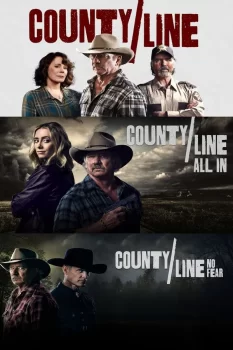 Wow. It’s been over half a year since I did a What I’ve Been Watching. I’ve already forgotten some of the stuff I watched since then! But let’s tackle a few more recent favorites. And what I’m re-watching, as usual.
Wow. It’s been over half a year since I did a What I’ve Been Watching. I’ve already forgotten some of the stuff I watched since then! But let’s tackle a few more recent favorites. And what I’m re-watching, as usual.
COUNTY LINE
From 2017 through 2022, there were three TV movies (is that still ‘a thing’) in this series. I did not recognize the main actor away. He reminded me of Dan Dierdorf, but I had to look him up on IMDB. It was good ol’ Tom (Luke Duke) Wopat!
He’s Alden Rockwell, a sheriff/former sheriff in some Georgia country town. The city is split down the middle between two counties. So, you’ve got Alden, and the sheriff of the other county, involved in the same case. In the first one, Alden’s best friend (and sheriff) is shot, so he tries to solve the crime – and there’s a bigger thing going.
There are plenty of familiar faces, which I enjoy. Patricia Richardson (Tim Allen’s wife on Home Improvement) owns the diner that is a common hangout. It’s on both sides of the county line. So Alden sits on one side of a table in a dry county. His buddy sits on the other side, where alcohol is legal. So, his buddy orders the beer and puts it on Alden’s side. It’s silly but works.
Jeff Fahey (Bodie’s grandfather on Fire Country) is a sheriff. Grant Goodeve (David on Eight is Enough) is in the second movie. Casper Van Dien (Starship Troopers) appears in the third one. I like seeing the faces from the past.
There’s that ‘Aw hell’ country cop resignation and humor, but it’s not a comedy. It’s a bit of a buddy cop movie, but not really.
Wopat is clearly the show’s center, and he’s good in the part. Looking older and rather beefy, he’s stubbornly likable.
I liked all three. The last two were both done in 2022, and it looks like the series is done. But it’s a fun little watch on Prime.
THE BONDSMAN
 ‘Resurrected bounty hunter Hub Halloran gets an unexpected second chance at life, love and his nearly forgotten musical career – only to find that his old job now has a demonic new twist.’
‘Resurrected bounty hunter Hub Halloran gets an unexpected second chance at life, love and his nearly forgotten musical career – only to find that his old job now has a demonic new twist.’
That’s a pretty good summary, from IMDB. Near the beginning of the opener, which is an Amazon original series, Kevin Bacon is killed while on a bounty hunting job. But he immediately comes back to life. He’s now hunting down demons, for Satan.
It’s not a comedy, but it’s got a lot of funny. The redneck setting makes it more fun, as well. Beth Grant is hilarious as his mom. She’s cut from the same vein as Ruth Gordon, Clint Eastwood’s mom in Every Which Way But Loose, and the sequel. She’s feisty, funny, and tough, as a former partner in the business.
The story line has high stakes, both on earth and for the afterlife. And the cliffhanger ending of episode eight absolutely sets up season two. I think Kevin Bacon – looking like life rode him hard and hung him up, is excellent in the lead.
The gore factor occasionally approaches my limit, but not too often. I don’t do horror, but I really enjoyed this, and look forward to season two. Highly recommended.
BOSCH: LEGACY
Michael Connelly’s Bosch books are huge sellers. The Amazon original series Bosch (which I wrote about here) covered 68 episodes over 7 seasons, from 2014-2021. Titus Welliver previously had over 100 credits, but Harry Bosch made him a star. And he’s perfect in the role. Strong cast, intense season-long story lines, and quality production values, Bosch should be looked at as a terrific adaptation of a best-selling book series.
 It was already announced that there would be a sequel series, Bosch: Legacy. With many of the same actors returning in their roles, Bosch has transitioned from being a cop, to a private investigator. He wasn’t exactly totally committed to the rules as an LA. homicide detective, but he’s got a lot more ‘flexibility’ as a PI.
It was already announced that there would be a sequel series, Bosch: Legacy. With many of the same actors returning in their roles, Bosch has transitioned from being a cop, to a private investigator. He wasn’t exactly totally committed to the rules as an LA. homicide detective, but he’s got a lot more ‘flexibility’ as a PI.
I really liked the original show. I liked the first two seasons of the sequel well-enough. I wasn’t as invested in it. However, season three was its strongest, and I think the series finished strongly, as it’s time for a spin-off.
Renee Ballard, played by Maggie Q, was an LAPD detective in the final episode of Legacy. She is the star of Ballard, which is to start airing later this year. Welliver will reprise his role in one episode. I thought her character was okay, and I’ll watch it to stay in the Bosch-verse.
One thing I really liked is that final season – and final episode – delivered on ‘Everybody matters, or no one matters.’ That little maguffin was dropped in the first season of the original Bosch, and mentioned more than once after in both series. And they paid it off. I appreciated that.
Season one of Bosch was almost too dark for me, but I continued on, and I have enjoyed my Bosch adventure. I would absolutely watch the original series: Legacy would be much less impactful if you watched it first. I’d even venture to say, it really wouldn’t work that great.
Side note – Welliver narrated the first several audiobooks for Robert B. Parker’s (Spenser for Hire) Cole and Hitch Westerns. Ed Harris made and starred in a very good version of the first one, Appaloosa, which I wrote about, here. Welliver is FANTASTIC. It’s a crime that Amazon or somebody has not signed him on to play Virgil Cole in a few movies, or a streaming series based on the books. He would be terrific.
AND….
Next installment, I’m going to cover Daredevil, and Daredevil: Born Again. I talked about Daredevil a bit a few months ago, and I think it’s my favorite Marvel series. And the reboot was very good.
I finally got around to watching The Chosen – from start to current. It’s a SUPERB show that deeply draws on the four gospels. It’s an amazing show and I can’t wait for the new season this Summer. They’re up to the Last Supper.
I am current on season three of Will Trent, which is an excellent cop show, with a little bit of Monk about it (and you know I loved that era of the USA Network). I’m gonna tackle that one as well.
I am in the middle of season three (of four) of my re-watch of Shakespeare and Hathaway: Private Investigators. This is a cute buddy cop/PI show with more of a Hallmark vibe, than something like The Bay (wrote about that here). It’s kind of in the same vein as Murder They Hope, which was originally three TV movies, then became a two mini-season series. Fun, lighthearted British mystery stuff. I re-watched all of that franchise, as well.
And I am almost to the end of season eleven of my Death in Paradise complete re-watch. Season fourteen, with yet another major cast change, finished dropping in March. I’m still working on it, while watching lots of other stuff. It remains one of my favorite shows.
I talked about Shakespeare and Hathaway, and Death in Paradise, in this Britbox-centric post.
I finished the current season of Krapopolis. I like it, but it’s all kinda the same. I don’t binge that one.
Some previous entries on things to watch:What I’ve Been Watching: May 2025 (What We Do in the Shadows, The Bay, Murder in a Small Town)
What I’m Watching – November 2023 (Brooklyn Nine-Nine, The Caine Mutiny Court Martial, A Haunting in Venice)
What I’m Watching – April 2023 (Florida Man, Picard – season three, The Mandalorian)
The Pale Blue Eye, and The Glass Onion: Knives Out
Tony Hillerman’s Dark Winds
The Rings of Power (Series I wrote on this show – all links at this one post)
What I’m Watching – December 2022 (Frontier, Leverage: Redemption)
What I’m Watching – November 2022 (Tulsa King, Andor, Fire Country, and more)
What I’m Watching – September 2022 (Galavant, Fire Fly, She-Hulk, and more)
What I’m Watching- April 2022 (Outer Range, Halo, Why Didn’t They Ask Evans, and more)
When USA Network was Kicking Major Butt (Monk, Psych, Burn Notice)
You Should be Streaming These Shows (Corba Kai, The Expanse, Bosch, and more)
What I’m BritBoxing – December 2021 (Death in Paradise, Shakespeare & Hathaway, The Blake Mysteries, and more)
To Boldly Go – Star Treking – (Various Star Trek incarnations)
What I’ve Been Watching – August 2021 (Monk, The Tomorrow War, In Plain Sight, and more)
What I’m Watching – June 2021 (Get Shorty, Con Man, Thunder in Paradise, and more)
Tucker and Dale vs. Evil
What I’ve Been Watching – June 2021 (Relic Hunter, Burn Notice, Space Force, and more)
Appaloosa
Psych of the Dead
The Mandalorian
What I’m Watching: 2020 – Part Two (My Name is Bruce, Sword of Sherwood Forest, Isle of Fury, and more)
What I’m Watching 2020: Part One (The Adventures of Brisco County Jr, Poirot, Burn Notice, and more)
Philip Marlowe: Private Eye
Leverage
Nero Wolfe – The Lost Pilot
David Suchet’s ‘Poirot’
Sherlock Holmes (over two dozen TV shows and movies)

Bob Byrne’s ‘A (Black) Gat in the Hand’ made its Black Gate debut in 2018 and has returned every summer since.
His ‘The Public Life of Sherlock Holmes’ column ran every Monday morning at Black Gate from March, 2014 through March, 2017. And he irregularly posts on Rex Stout’s gargantuan detective in ‘Nero Wolfe’s Brownstone.’ He is a member of the Praed Street Irregulars, founded www.SolarPons.com (the only website dedicated to the ‘Sherlock Holmes of Praed Street’).
He organized Black Gate’s award-nominated ‘Discovering Robert E. Howard’ series, as well as the award-winning ‘Hither Came Conan’ series. Which is now part of THE Definitive guide to Conan. He also organized 2023’s ‘Talking Tolkien.’
He has contributed stories to The MX Book of New Sherlock Holmes Stories — Parts III, IV, V, VI, XXI, and XXXIII.
He has written introductions for Steeger Books, and appeared in several magazines, including Black Mask, Sherlock Holmes Mystery Magazine, The Strand Magazine, and Sherlock Magazine.
You can definitely ‘experience the Bobness’ at Jason Waltz’s ’24? in 42′ podcast.
Her First Mistake (by Kendra Elliot)
13 years earlier Noelle Marshall survived the brutal attack that killed her husband. As a high profile and well connected politician his murder was investigated by the FBI but because Noelle only had patchy memories of the attack the investigation went nowhere.
After the death, one of the investigating agents encouraged Noelle to pursue a career in law enforcement and following that path led her to becoming a detective with the Oregon State Police.
But after 13 years the FBI are taking another look at the murder of her husband to see if anything shakes loose.
And something has. Noelle has said or done something that has made the killer start to suspect her memories are returning but she has no idea what that is. Now with the help of the two FBI Agents she must dig up the truth of her husbands murder before the murderer silences her forever.
–––––––––––––––––––––––––––––––––––––––––––––––––––––––––––––––––––––––––––––––
Noelle Marshall has been floating in the background of Kendra Elliot’s Columbia River series for a few books now. She has become a fan favorite and finally she is getting her own series. And she doesn’t disappoint. Her First Mistake is much more cerebral than previous books but it is tight, gripping and an edge of your seat thrill ride.

Half a Century of Reading Tolkien: Part Four – The Return of the King by JRR Tolkien
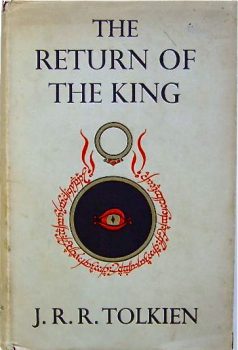 A wild light came into Frodo’s eyes. ‘Stand away! Don’t touch me!’ he cried. ‘It is mine, I say. Be off!’ His hand strayed to his sword-hilt. But then quickly his voice changed. ‘No, no, Sam,’ he said sadly. ‘But you must understand. It is my burden, and no one else can bear it. It is too late now, Sam dear. You can’t help me in that way again. I am almost in its power now. I could not give it up, and if you tried to take it I should go mad.’
A wild light came into Frodo’s eyes. ‘Stand away! Don’t touch me!’ he cried. ‘It is mine, I say. Be off!’ His hand strayed to his sword-hilt. But then quickly his voice changed. ‘No, no, Sam,’ he said sadly. ‘But you must understand. It is my burden, and no one else can bear it. It is too late now, Sam dear. You can’t help me in that way again. I am almost in its power now. I could not give it up, and if you tried to take it I should go mad.’
Frodo to Sam in Mount Doom from The Return of the King
And so we come to the end of the first part of my return to JRR Tolkien’s work. For those not following along with my earlier essays (links at the bottom), inspired by a hate watch of Peter Jackson’s Lord of the Rings movies, I picked up The Fellowship of the Ring and quickly succumbed to a complete reread of the trilogy. As I set out to write an article about Fellowship, I instead, found myself realizing I’ve been reading the professor’s books for fifty years and how much they’d meant to me.
Last time, I wrote that when I was young, I tended to struggle through bits of The Two Towers. That was never the case with The Return of the King, something that I found to remain so on this reading. It’s got wilder and bigger battles than the previous book, incredible scenes (including one of the greatest in all three books and that Jackson insanely cut omitted from the theatrical release!), and Frodo’s and Sam’s journey becomes more desperate and its evocation of Christ-like self-sacrifice more potent. The penultimate chapter, The Scouring of the Shire, portrays the transformation wrought on the four hobbits by their undertakings. Finally, the book ends with one of my favorite closing lines of any book.
As usual, here’s let me give a brief synopsis for those who’ve yet to read The Lord of the Rings. The first half of the book, The War of the Ring, contains three narratives. Gandalf and Pippin set off for Minas Tirith while Merry rides with the Rohirrim, again, for Minas Tirith, but by a different route. Meanwhile, Legolas and Gimli follow Aragorn along the Paths of the Dead in search of supernatural allies.
Everyone comes together at Minas Tirith at various stages in the great siege of the city and the ensuant battle outside its wall. When Mordor’s forces are broken and scattered, under Aragorn’s command, an army is sent north to the Gates of Mordor with hopes of distracting Sauron’s unblinking eye from Frodo and Sam.
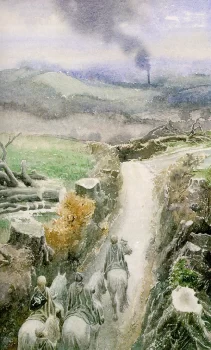 Homeward Bound by Alan Lee
Homeward Bound by Alan Lee
The End of the Third Age, the book’s second half, can be broken into several parts; the final leg of Frodo’s and Sam’s march to Mount Doom, the reunion of the surviving members of the Fellowship and Aragorn’s coronation, the scouring of the Shire, and a final farewell to Middle-earth. As with The Two Towers, this part of the trilogy evokes Tolkien’s wartime service, if not as in a direct way. On the one hand, both Merry and Pippin are transformed into hobbits of action and steel. There is nothing left that scares them. On the other, Frodo, never fully recovered from his wound on Weathertop, has been left drained and tired in the deepest parts of his soul by bearing the One Ring for so long, straight into the Enemy’s domain.
Each time around with LotR, I find myself noticing something new or being drawn with greater interest to a different part than previously. This time it was The Scouring of the Shire. I think, partially, it’s the better understanding that the fight against evil is never ending, and just as likely to happen in your own town as on some distant fields. More significantly, it was Frodo’s place in it. I remembered him as instrumental in the routing of Sharkey’s forces, but that is not the case at all.
When Frodo and Sam decide to lighten their load and ditch the orc gear weighing them down, Frodo makes an emphatic statement that “I’ll bear no weapon, fair or foul.” When it becomes clear that there are hobbits working for Sharkey and his ruffians, he issues an order:
“‘Fight?’ said Frodo. ‘Well, I suppose it may come to that. But remember: there is to be no slaying of hobbits, not even if they have gone over to the other side. Really gone over, I mean; not just obeying ruffians’ orders because they are frightened. No hobbit has ever killed another on purpose in the Shire, and it is not to begin now. And nobody is to be killed at all, if it can be helped. Keep your tempers and hold your hands to the last possible moment!’”
Pippin and Merry are ready to fight and do so when the time comes. Merry himself kills the leader of the ruffians. Frodo, though, doesn’t draw his sword and remains out of the battle. When it’s over, he steps in “to prevent the hobbits in their wrath at their losses, from slaying those of their enemies who threw down their weapons.”
Merry and Pippin prove themselves the highborn leaders they were always destined to be in the battle against the ruffians. It’s Frodo, though, after having suffered mightily and seen his share of death and destruction, who will have no more of it. I simply didn’t remember this aspect of Frodo. When we read that even the normally mild-mannered citizens of the Shire are pressing to kill their prisoners, it’s clear how different from them Frodo has become.
I understand Jackson omitting the scouring from his films. He’s had his big beat climax and the last chapter, wherein Frodo and several others exit the stage for good works well enough for a movie. What we lose, though, is the impact of learning that even the innocents of the Shire have been damaged by the war, and that even they can be driven to killing and murderous rage. In a land where presumably there’s never a murder, they suddenly have nearly a hundred corpses on their hands.
We also miss out that the once mighty Saruman, now reduced to a pitiful state, has become petty and spiteful. When finally confronted by the hobbits he revels in what he’s done to the Shire.
I have already done much that you will find it hard to mend or undo in your lives. And it will be pleasant to think of that and set it against my injuries.’
Despite many hobbits calling out to kill Saruman, Frodo only dismisses him with a sense of pity, largely for the noble being he once was. He even offers temporary sanctuary to Grima and the chance to escape his master’s control. From the beginning, Frodo is portrayed as a good person, but surviving the burden of the Ring seems to have turned into an outright noble one, something I don’t think I’ve tracked as closely before.
In the last few years, especially, it seemed, after the movies came out, there was a lot of talk that Sam Gamgee was the real hero of LotR. After this read, I think I’ve come around to that. Frodo sets out to take the Ring to Mount Doom, always with a sense of fatalism. His ownership of the Ring makes him feel obligated to take it to the end and he never has any doubts about what needs to be done.
Sam, however, chooses to go out of loyalty to Frodo, not for any sense of obligation to destroy the Ring. That does come upon him later when he thinks Frodo dead. He is the one tempted along the way, first by the visions in the Mirror of Galadriel and later by the Ring itself. He hesitates for a moment each time, but doesn’t falter. In fact, he is the only person we ever read of in the books or the appendices who gives up the Ring willingly. In a scene Jackson left out, Sam is tested and proved strong.
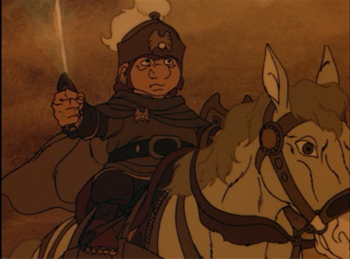 Samwise the Strong from Rankin and Bass
Samwise the Strong from Rankin and Bass
His thought turned to the Ring, but there was no comfort there, only dread and danger. No sooner had he come in sight of Mount Doom, burning far away, than he was aware of a change in his burden. As it drew near the great furnaces where, in the deeps of time, it had been shaped and forged, the Ring’s power grew, and it became more fell, untameable save by some mighty will. As Sam stood there, even though the Ring was not on him but hanging by its chain about his neck, he felt himself enlarged, as if he were robed in a huge distorted shadow of himself, a vast and ominous threat halted upon the walls of Mordor. He felt that he had from now on only two choices: to forbear the Ring, though it would torment him; or to claim it, and challenge the Power that sat in its dark hold beyond the valley of shadows. Already the Ring tempted him, gnawing at his will and reason. Wild fantasies arose in his mind; and he saw Samwise the Strong, Hero of the Age, striding with a flaming sword across the darkened land, and armies flocking to his call as he marched to the overthrow of Barad-dûr. And then all the clouds rolled away, and the white sun shone, and at his command the vale of Gorgoroth became a garden of flowers and trees and brought forth fruit. He had only to put on the Ring and claim it for his own, and all this could be.
In that hour of trial it was the love of his master that helped most to hold him firm; but also deep down in him lived still unconquered his plain hobbit-sense: he knew in the core of his heart that he was not large enough to bear such a burden, even if such visions were not a mere cheat to betray him. The one small garden of a free gardener was all his need and due, not a garden swollen to a realm; his own hands to use, not the hands of others to command.
Sam is the reason Frodo succeeds in reaching the furnace at Mount Doom. He rescues him from Cirith Ungol and later he carries him up the slopes of the volcano. He also matures along the journey. Several times in The Two Towers he is set to kill Smeagol. When given the chance to kill him again in this book, Sam finds himself unable to. Even though his time with the Ring was short, it has taught him much.
 Mount Doom by John Howe
Mount Doom by John Howe
‘Now!’ said Sam. ‘At last I can deal with you!’ He leaped forward with drawn blade ready for battle. But Gollum did not spring. He fell flat upon the ground and whimpered.
‘Don’t kill us,’ he wept. ‘Don’t hurt us with nassty cruel steel! Let us live, yes, live just a little longer. Lost lost! We’re lost. And when Precious goes we’ll die, yes, die into the dust.’ He clawed up the ashes of the path with his long fleshless fingers. ‘Dusst!’ he hissed.
Sam’s hand wavered. His mind was hot with wrath and the memory of evil. It would be just to slay this treacherous, murderous creature, just and many times deserved; and also it seemed the only safe thing to do. But deep in his heart there was something that restrained him: he could not strike this thing lying in the dust, forlorn, ruinous, utterly wretched. He himself, though only for a little while, had borne the Ring, and now dimly he guessed the agony of Gollum’s shrivelled mind and body, enslaved to that Ring, unable to find peace or relief ever in life again. But Sam had no words to express what he felt.
‘Oh, curse you, you stinking thing!’ he said. ‘Go away! Be off! I don’t trust you, not as far as I could kick you; but be off. Or I shall hurt you, yes, with nasty cruel steel.’
Could Sam have carried the Ring himself to Mount Doom himself, probably not. But Frodo, for all his spiritual resilience, fails in the end. Only with Sam’s help could he have even made it to that point. Tolkien himself referred to Sam as the “chief hero,” so I guess I’ll have to go along with that.
Which leads me to Peter Jackson’s version. Instead of Frodo overwhelming Smeagol and dominating him by the power of the Ring. Which means we miss this:
‘Down, down!’ he gasped, clutching his hand to his breast, so that beneath the cover of his leather shirt he clasped the Ring. ‘Down, you creeping thing, and out of my path! Your time is at an end. You cannot betray me or slay me now.’
Then suddenly, as before under the eaves of the Emyn Muil, Sam saw these two rivals with other vision. A crouching shape, scarcely more than the shadow of a living thing, a creature now wholly ruined and defeated, yet filled with a hideous lust and rage; and before it stood stern, untouchable now by pity, a figure robed in white, but at its breast it held a wheel of fire. Out of the fire there spoke a commanding voice.
‘Begone, and trouble me no more! If you touch me ever again, you shall be cast yourself into the Fire of Doom.’
Instead of Sam refraining from killing him as described above, there’s a short, vicious encounter that ends with Sam cutting Smeagol in the belly. It continues Jackson’s rejection of nuance and complication for action every time.
There are so many problems I have with the movie. Two-trunked titanic oliphaunts that Legolas parkours on, well, they’re bad. Worst of all is the denigration of Denethor. Tolkien’s character is a man of great learning who has been lured into despair by his contact with Sauron. A once noble man has fallen into such hopelessness that he can’t even imagine there’s any chance of survival. Instead, Jackson gives us a snide, snarling man who makes Pippin sing for him while he devours food like an animal, juices dribbling down his face. Again, nuance of character has no place.
One thing that particularly stands out is the elimination of, what’s for me, one of the most iconic moments in The Return of the King. When the great gate of Minas Tirith is broken down, Gandalf confronts the Witch King. That Jackson chose to make up his own scenes and dialogue for the movies but excised this one, well, it’s inexcusable.
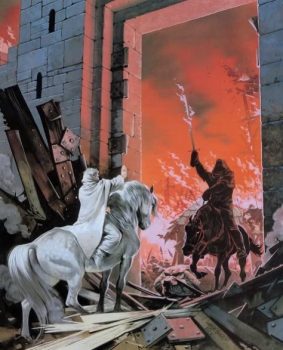 Witch King at the Gate by Angus McBride
Witch King at the Gate by Angus McBride
Thrice he cried. Thrice the great ram boomed. And suddenly upon the last stroke the Gate of Gondor broke. As if stricken by some blasting spell it burst asunder: there was a flash of searing lightning, and the doors tumbled in riven fragments to the ground.
In rode the Lord of the Nazgûl. A great black shape against the fires beyond he loomed up, grown to a vast menace of despair. In rode the Lord of the Nazgûl, under the archway that no enemy ever yet had passed, and all fled before his face.
All save one. There waiting, silent and still in the space before the Gate, sat Gandalf upon Shadowfax: Shadowfax who alone among the free horses of the earth endured the terror, unmoving, steadfast as a graven image in Rath Dínen.
‘You cannot enter here,’ said Gandalf, and the huge shadow halted. ‘Go back to the abyss prepared for you! Go back! Fall into the nothingness that awaits you and your Master. Go!’
The Black Rider flung back his hood, and behold! he had a kingly crown; and yet upon no head visible was it set. The red fires shone between it and the mantled shoulders vast and dark. From a mouth unseen there came a deadly laughter.
‘Old fool!’ he said. ‘Old fool! This is my hour. Do you not know Death when you see it? Die now and curse in vain!’ And with that he lifted high his sword and flames ran down the blade.
Gandalf did not move. And in that very moment, away behind in some courtyard of the City, a cock crowed. Shrill and clear he crowed, recking nothing of wizardry or war, welcoming only the morning that in the sky far above the shadows of death was coming with the dawn.
How do you decide to introduce those ridiculous looking oliphaunts but leave this out? Who the heck knows. To me, it seems like a terrible appreciation for what’s really cool and awesome. That said, the charge of the Rohirrim and the death of the Witch King are pretty solid.
In the beginning, I came to The Lord of the Rings just as the sequels to The Hobbit. Gradually, I understood they had something to say, artistically and thematically. Gradually, the complex architecture of the books and the characters became clearer. This time around, I think the tragic elements have resonated the most — the fallen state of Middle-earth, Boromir’s and his father’s fates, Smeagol’s, too, of course, and, ultimately, Frodo’s. By the last pages, all the magic has flowed out of Middle-earth and its fate is in the hands of men.
I really don’t know how many times I’ve read these books. There was a period where I read them every year or two. Nonetheless, each time I come back to them, it’s almost like I’m reading them for the first time. I’ve read my share of ridiculously big epic fantasies, but none of them have really earned their length in the way these books have. I can’t say when, but I will be rereading them sooner rather than later.
So, what’s next? I’m not sure. My plans include reading The Hobbit, The Silmarillion, and definitely Bored of the Rings. I might finally crack open my copies of The Fall of Gondolin and Beren and Luthien, too. I hope you’re willing to follow me along.
Gandalf and the Witch King from Rankin and Bass’ The Return of the King
Half a Century of Reading Tolkien: Part One
Half a Century of Reading Tolkien: Part Two – The Fellowship of the Ring by JRR Tolkien
Half a Century of Reading Tolkien: Part Three — The Two Towers by JRR Tolkien
Fletcher Vredenburgh writes a column each first Sunday of the month at Black Gate, mostly about older books he hasn’t read before. He also posts at his own site, Stuff I Like when his muse hits him
Book Review: The Staircase in the Woods by Chuck Wendig
I received a review copy from the publisher. This does not affect the contents of my review and all opinions are my own.
 The Staircase in the Woods by Chuck Wendig
The Staircase in the Woods by Chuck Wendig
Mogsy’s Rating: 3.5 of 5 stars
Genre: Horror
Series: Stand Alone
Publisher: Del Rey (April 29, 2025)
Length: 400 pages
Author Information: Website
I rarely miss picking up a new Chuck Wendig book, which is why I really wanted to love The Staircase in the Woods. I guess in some ways, I did—but it also took me way longer to finish than I expected. Despite a strong beginning and end, I found myself bogged down by the middle section which felt repetitive and a bit bloated, slowing down momentum.
Still, there’s no denying this book has one hell of a killer premise! It features a group of teenagers—Owen, Lore, Matty, Hamish, and Nick—who experience a supernatural tragedy one summer, reuniting decades later to confront the truth of what really happened. It all began in high school, when during one of their usual hangouts in the woods, the five friends stumble upon a strange spiral staircase rising out of the ground and leading to nowhere. One fateful night, buzzed on booze and bravado, Matty decides he wants to climb it—and he’ll even do it by himself, if the others are too chicken. Only, upon ascending, he vanishes without a trace. The rest of the group is left traumatized and grief-stricken, blamed by the community for their friend’s disappearance. Shattered by guilt and unanswered questions, they eventually graduate and go their separate ways.
Twenty years later, however, Nick reaches out to the others with dire news and a request: first, he has terminal cancer, and second, he wants to find out what happened to Matty. Reluctant but unable to refuse their dying friend, Lore, Owen, and Hamish agree to meet. They learn that Nick has found the damned staircase again, and this time when he leads them to it, they all make the climb. But the mystery of what befell Matty isn’t going to be solved so easily. In fact, things get weird fast. The friends find themselves inside a house that shouldn’t exist, a surreal place where each room forces them to face their deepest fears and relive their worst memories. They soon realize the house is playing with them, feeding off their pain. And while they have come to find Matty, it’s uncertain now whether any of them will make it out alive.
I’ll start with the positives. The supernatural elements in The Staircase in the Woods are certainly effective when it comes to the chill factor, even more so when I learned from the author’s note that he drew inspiration from real reports of mysterious staircases found in the middle of wooded areas, including one he personally encountered. While many of these sightings turn out to have perfectly rational and mundane explanations—like remnants of old photography and hunting platforms, or abandoned houses where the rest of the structure has fallen around the staircase and long since been reclaimed by nature—the idea still struck me as creepy. After all, the imagery itself is rather unsettling, making it easy to imagine other uncanny possibilities.
Clearly, much of the novel was also driven by tensions between the characters, a result of all their psychological and emotional baggage. As the saying goes, you can run but you can’t hide, and no matter how hard they’ve tried, none of the remaining four friends can move on from what happened to Matty. Even after achieving moderate success as a game designer, Lore remains deeply unhappy and feels victimized by everyone around her (and some of her political rants can be a bit much). Owen is a nervous wreck, and his anxiety has only worsened since his high school days. Hamish, the only one married with children, is nonetheless unsatisfied and self-destructive. And although Nick may act like a clown, the humor is merely a mask that hides the true desperation within him. To be honest, none of them are particularly likeable, but they are complex and feel genuine. I loved reading about their relationships in the past and in the present, and the most rewarding part was seeing how these connections are broken and healed again.
But now for the not-so-great. Like I said, not everything worked for me, particularly the story’s pacing. While it was smooth sailing for most of the first half, soon after, the plot started spinning its wheels. The characters end up splitting up, spending a long time moving through this house of horrors, with each room throwing more and more terrible things at them until these scenes begin to lose all meaning. At some point, it all feels done for the sake of shock value. The scares also blur together and become more of the same old, same old. I definitely struggled to get through this middle section, putting the book down multiple times then finding it hard to motivate myself to pick it back up again.
That said, picking it back up again I did, and I’m glad. Once the holding pattern finally breaks, the plot gets right back down to business, pushing forward rather than lingering in its own sluggish atmosphere. The payoff at the end of the book was well worth the wait, and the story’s resolution tied its themes of friendship, grief, and recovery back to the way things were for the characters before Matty’s disappearance tore them apart. Needless to say, I was happy with the conclusion, which was both satisfying and touching.
Despite my misgivings into its pacing issues, I would still recommend The Staircase in the Woods, especially if you enjoy stories about unexplained mysteries, haunted forests, and reunions between even more haunted friends. Admittedly, this one took a bit of a climb for me, but in the end there was still plenty to like.
![]()
![]()
Tubi Dive, Part IV
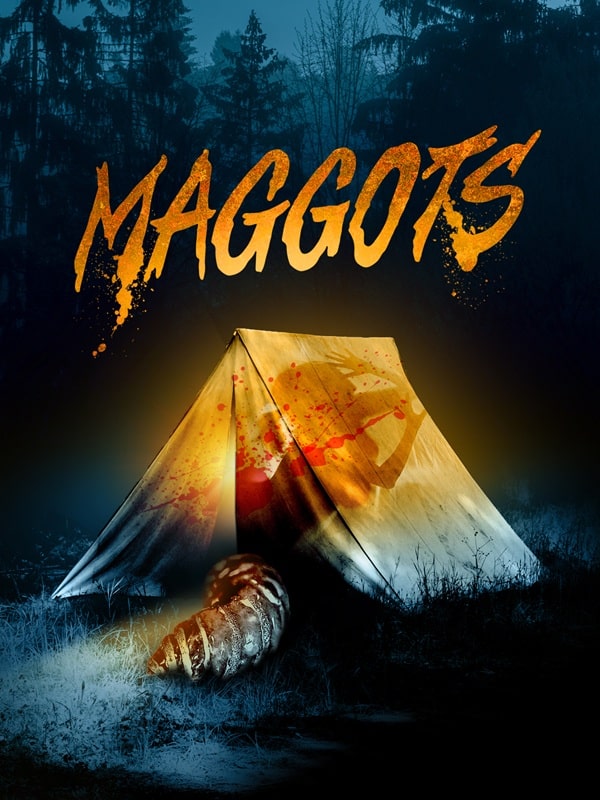 Maggots (JO JO New Media, 2017)
Maggots (JO JO New Media, 2017)
50 films that I dug up on Tubi.
Enjoy!
Maggots (2017)Despite usually taking the piss out of bad movies, I do have respect for filmmakers that actually complete them and get them seen. This brings us to Maggots — a horror/comedy that gets a couple of things right, and a lot wrong, but again I just can’t get mad at it.
The premise is simple; evil corporation dumping toxic sludge after fracking, bugs get mutated, bunch of disposables go camping.
The good stuff: the lead (Lawrence George) is good in his role as a nerdy science student who wants to expose the evil corporation, and the maggots are a lot of fun. They really reminded me of the Deadly Spawn, or naked Crites (from Critters). They are for the most part practical rubber effects, looking like fleshy windsocks with teeth.
The bad stuff: the script is terrible, and the acting goes from soulless mumble to shout. The director obviously thought one of his actors was hilarious, because we are subjected to his garbled nonsense throughout (this is comedy). We are told at the beginning of the film that his character suffers from ‘Sarcastic Tourette’s’ — so I guess I’m supposed to feel bad for disliking his banal schtick.
Anyhoo, we have the nerd, a tough female, a female willing to get her top bollocks out, a jock and a weirdo, along with a randy college professor and a pair of inept forest rangers, so the trope box is thoroughly ticked.
Honestly, I finished this one wanting to enjoy it more, and I can’t help thinking that if it had been played straight, and kept the goofy maggot puppets, this would have been a banger.
Fun fact — I gave it a higher rating than Rebel Moon on Letterboxd.
4/10
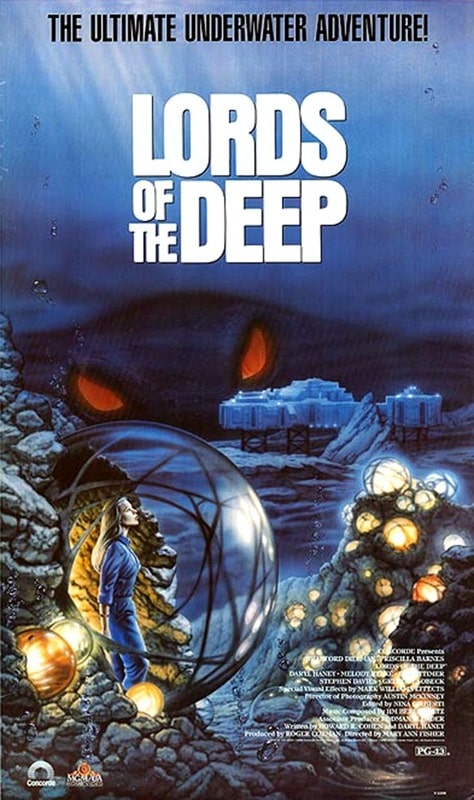
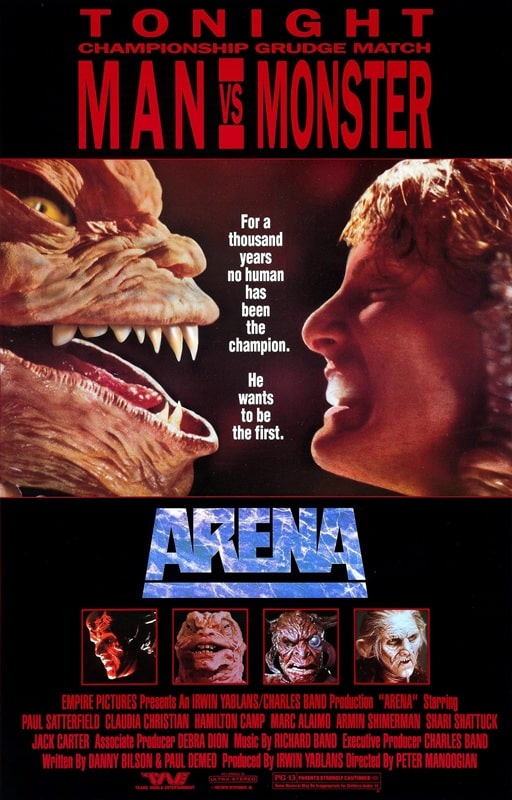
Lords of the Deep (Concorde Pictures, April 21, 1989) and Arena (Empire Pictures, March 29, 1989)
Fancied some cheap-looking rubbish, and luckily Tubi has an extensive Roger Corman collection.
It is the future, and once again we have messed up the planet. Therefore humanity has turned to the depths for somewhere new to screw up, and we hang with the crew of an exploratory vessel as they look for something or other. Lots of blue jumpsuits and sparsely decorated corridors ensue, before it all goes a bit Abyss, and the aliens start doing their thang. The undersea aliens messed up their own world and are here to tell us, in condescending Gort fashion, to stop our shenanigans. The aliens, a cross between a badly-folded fitted sheet and a flip-flop, are actually nice — so why are crew members dying? Could it be something to do with shifty-looking Bradford Dillman? You’ll never guess.
Fun fact: while reading up about this flick, I learned that two-time Oscar winner Janusz Kamiński was the DP, but was fired for being too good. Roger also cameos in this, but then he cameos in everything, bless him.
All in all, a bit pants.
3/10
Arena (1989)I wanted to chase the previous slice of Corman bunkum with one of his would-be heirs, and Charles Band has always been a reliable option. Empire Entertainment was catnip to weirdos like me in the 80s and yet, to my shame, I never got around to seeing Arena.
Well, I’ve fixed that oversight, and I’m jolly glad I did.
Empire is the company that churned out a ton of cheapo gore fests, normally with an incredibly daft premise, including beloved classics such as Ghoulies, Terrorvision, and Troll — and also produced stone-cold classics such as Trancers, Re-Animator and From Beyond.
Charles must have had decent cash flow going on, because he threw a bunch at this film — the production design is pretty good and the film is chockablock with prosthetics, animatronic beasties and derpy background artists. That said, one fun activity to do while watching is to count the mannequins in the medium crowd shots and the wiggling Q-tips in the wide shots. It’s all good though — clever mattes and inspired shot choices really pull this film together.
The story is about the heroically-named Steve Armstrong, a short-order cook who is handy with his fists. He ends up on the fighting circuit, and has the chance to be the first human in a long time to be champ. It’s all very Rocky, but everyone gives it their all, from Paul Satterfield as Steve, to Claudia Christian as his ‘owner’, Quinn. There’s a fun turn by Armin Shimerman under a couple of pounds of rodent rubber, playing a scummy henchman called Weezil, and Hamilton Camp playing a four-armed Nebulan called Shorty.
It’s all very silly, the actual fights are hilariously great and Richard Band’s music is on point. I had a fun time.
7/10

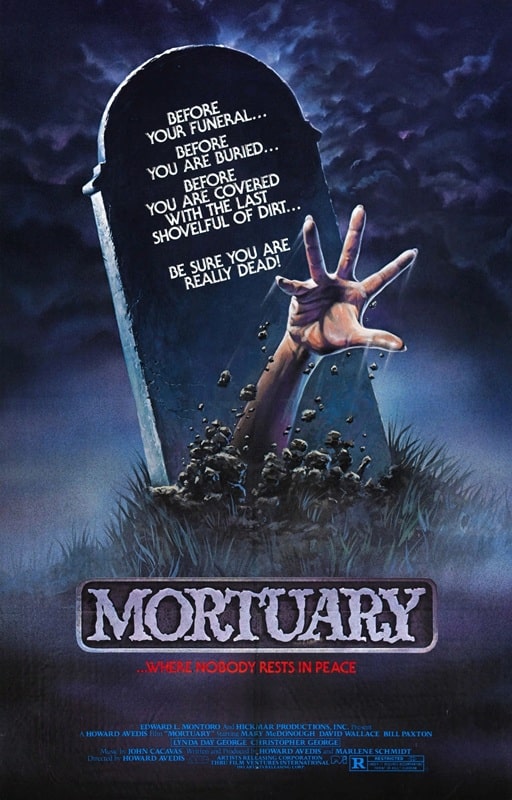
Zombie Ass: Toilet of the Dead (Nikkatsu, September 24, 2011)
and Mortuary (Film Ventures International, May 7, 1982)
This is the 25th review in our Tubi Dive, and we celebrate the quarter-century mark with quite possibly the most bonkers, disgusting, and hilarious film so far.
I’ve been a fan of Noboru Iguchi ever since I sat down to watch Machine Girl featuring the mind-blowing special effects of Yoshihiro Nishimura (who went on to direct Tokyo Gore Police), so imagine my delight when I stumbled upon a small collection of his films on Tubi. I’m going to watch them all — and I’ve started with this insanely offensive film.
Traumatized by the death of her sister, karate student Megumi has agreed to go on a camping trip with the usual group of stereotypes. One of her companions, Maki, is a self-absorbed would-be model, and her goal is to find a parasite in a fish, swallow it, and lose weight (not that she needed to). She succeeds, but the resulting tummy rumbles have her rushing to a disgusting outhouse in an abandoned village.
As she pops a squat to clear her bowels, she is attacked from below by a crap-coated zombie and, you guessed it, shenanigans ensue. What follows is some of the most ridiculous, stomach-churning, gory, and childishly fun action scenes you’ll ever see. Iguchi clearly couldn’t give a monkey’s about what anyone thinks of his films, and sets out to have a blast (no doubt satisfying some of his more ‘unsavoury’ tastes) by lacing the film with so many off-the-wall moments, homages to The Evil Dead, unnecessary nudity, hundreds of poop and fart gags, and sexually-charged monster attacks that border on live action anime.
Some shots are poorly done CG, but for the most part the creature and gore effects are practical and messy. I feel like my hyperbole might be getting in the way, but I seriously had such a fun time with this one — and I honestly can’t recommend it to decent folk.
For fans of poop, farts, blood and knickers.
9/10
Mortuary (1982)Just had time to sneak in another old slasher before I carry on with more Japanese nuttiness, and here’s an old chestnut that tries to elevate the slasher genre with zero success.
Christie believes that her father’s drowning was no accident (it wasn’t), but no one believes her; not her red herring of a mother, nor her chad of a boyfriend. Eventually the truth is revealed, but not before some dull stuff happens. Mortuary has all the trappings of a typical slasher (group of friends, creepy backstory, ‘masked’ killer, unusual weapon) but doesn’t follow through on any of them. A shame really, as it could have been a decent romp. It does get bonus points though for featuring an adorable young Bill Paxton.
For completists only.
4/10

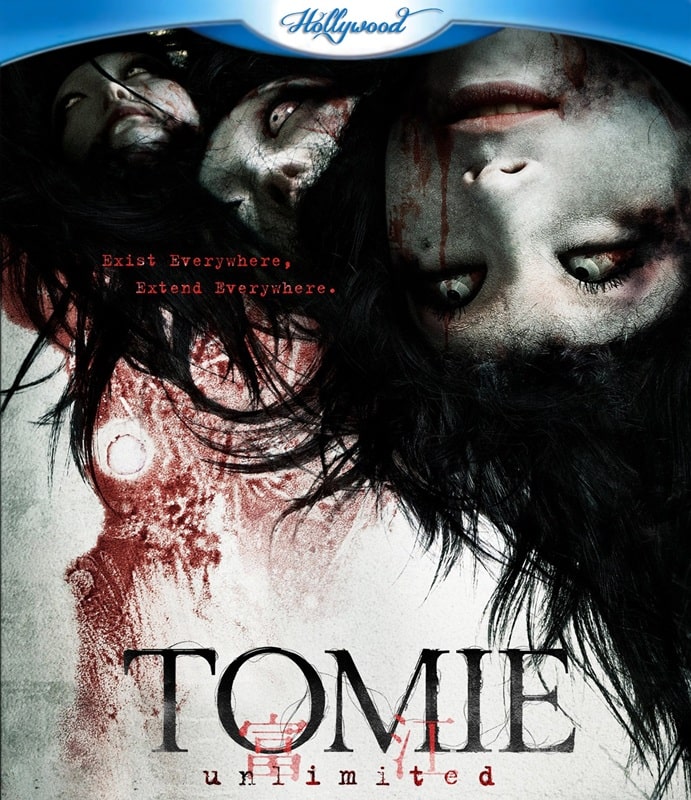
Dead Sushi (Alchemy/Millennium, 2012) and Tomie Unlimited (Toei Company, May 14, 2011)
Next on my Noboru Iguchi-thon is this diamond-encrusted slice of fried gold in video form. As equally bonkers as Zombie Ass, I didn’t enjoy this one quite as much, but don’t let that stop you from taking in this unique form of high culture.
In a nutshell (or seaweed cone), Keiko is the daughter of a famous sushi chef, but when she doesn’t measure up to his standards, she runs away to work as a hostess at a crummy inn. There she becomes embroiled in a surreal revenge story involving chemicals, dodgy sushi and dodgier businessmen.
Imagine for a moment how weird this film could possibly be. You’re dead wrong. It’s much weirder. In fact, one of the less weird moments is a tender scene between a girl and a slice of cooked egg.
Noboru really reminds me of Joe Dante, when Dante is on a live-action Looney Tunes kick (see Gremlins 2 or Twilight Zone), but with much less logic and much more in the way of farting and bosom fetishism.
Utterly stupid, and a whole heap of fun — the opening fight scene alone is worth your time. Watch it, you fools.
7/10
Tomie Unlimited (2011)The Noboru-thon continues with his take on the classic manga series created by Junji Ito. In the graphic novels (and 9 film adaptations), Tomie is portrayed as a demonic force; sometimes a succubus, other times a vengeful spirit, but always she is the catalyst for much screaming, stabbing and head-scratching.
Noboru Iguchi, being a big fan of rubber puppets, really leans into the body horror and has a whale of a time, even if the film is slightly more serious in tone than Dead Sushi or Toilet of the Dead.
There are some astonishingly weird scenes (almost House weird) on offer, with just a few moments marred by dodgy CG. On the whole though, it’s creepy, disgusting, and sublimely daft. Tomie is played really well by Miu Nakamara — she is all angular cheekbones and lacerating looks, and Moe Arai is perfectly cast as her put-upon younger sister. She’s Phoebe Cates adorable, and it is particularly rough to watch her being hurt both physically and mentally.
Not the best of the Tomie films, but certainly worth a look.
7/10
Previous Murkey Movie surveys from Neil Baker include:
Tubi Dive, Part I
Tubi Dive, Part II
Tubi Dive, Part III
What Possessed You?
Fan of the Cave Bear
There, Wolves
What a Croc
Prehistrionics
Jumping the Shark
Alien Overlords
Biggus Footus
I Like Big Bugs and I Cannot Lie
The Weird, Weird West
Warrior Women Watch-a-thon
Neil Baker’s last article for us was Part III of Tubi Dive. Neil spends his days watching dodgy movies, most of them terrible, in the hope that you might be inspired to watch them too. He is often asked why he doesn’t watch ‘proper’ films, and he honestly doesn’t have a good answer. He is an author, illustrator, teacher, and sculptor of turtle exhibits. (AprilMoonBooks.com).
Camelot Fantasy Novels | 6 Paths of Hope, Courage, Fairness and Justice
Camelot fantasy novels have always held a special place in our hearts, representing reading that…
The post Camelot Fantasy Novels | 6 Paths of Hope, Courage, Fairness and Justice appeared first on LitStack.
THE DEVILS by Joe Abercrombie
Tor Doubles #4: Samuel R. Delany’s The Star Pit and John Varley’s Tango Charlie and Foxtrot Romeo
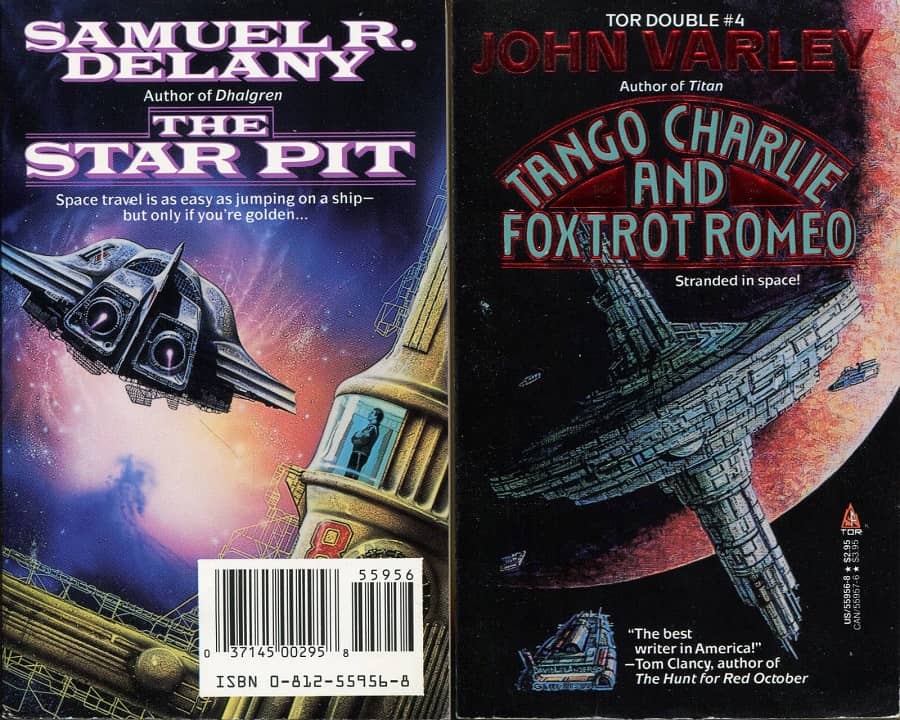 Cover for The Star Pit by Tony Roberts
Cover for The Star Pit by Tony RobertsCover for Tango Charlie and Foxtrot Romeo by David Lee Anderson
Originally published in January 1989, the fourth Tor Double included John Varley’s Tango Charlie and Foxtrot Romeo and Samuel R. Delany’s The Star Pit. Printed in the a tête-bêche format, David Lee Anderson provided the cover by Tango Charlie and Foxtrot Romeo and Tony Roberts was the artist for The Star Pit.
The Star Pit was originally published in Worlds of Tomorrow in February, 1967. It was nominated for the Hugo Award. It lost to Philip José Farmer’s “Riders of the Purple Wage” and Anne McCaffrey’s “Weyr Search,” which tied each other. Coincidentally, McCaffrey and Delany share a birthday.
Vyme, a mechanic at the titular Star Pit, serves as Delany’s narrator. Rather than start with the present day action, however, Vyme opens his narration with memories of his own childhood and his life from several years earlier. Born on the backwater Earth in New York, he talks about his childhood and the ant farm he had as a child, which would eventually break.
He also talks about his life after leaving earth participating in a procreation group, a futuristic group marriage which was meant to make child rearing easier for both parents and children. Mostly talking about his kid-boy Antoni, who had an ecologarium, a sort of ant farm on a larger scale, it is clear that at best, Vyme is an absentee father, using the structure of the procreation group to allow himself to travel off world to take jobs as a mechanic and nursing his alcoholism, which eventually leads to him abandoning his group marriage.
Eventually, Vyme sobers up, but not before he can no longer return to his group family. Instead, he is on a Star Pit, a way station in space which is used to dock and repair spaceships. He is aided in this by Sandy and a young prodigy, Ratlit, who at thirteen has written a novel despite being functionally illiterate. Ratlit also helps out Alegra, a drug-addicted girl two years older than he is.
Vyme, Ratlit, Sandy, and Alegra are living their lives on the Star Pit in a world which has significant space travel, but in order for it to happen, people need to be identified as “the golden,” individuals who can pilot starships and are the only ones who can travel beyond the galactic plane without going insane, although their sanity is in question in any event.
According the Vyme, the golden are stupid and mean and the details of his interactions with them certainly bear that out, as well as a certain pettiness and a parallel society which normal humans can only watch and not fully understand. When one golden kills another in Vyme’s shop, Vyme and Sandy take it in stride. The surviving golden claims ownership of the dead golden’s ship and, not wanting it, hands it over to Sandy.
The plot of The Star Pit, such as it is, is secondary to the characters and their relationships with each other. Despite Vyme’s paternal tendencies toward Ratlit and his mentoring of Sandy, or Ratlit taking care of Alegra and making sure she is being treated for her illnesses, none of the characters seem to particularly like each other. They have been thrown together by circumstances and deal with each other as best that can.
While Vyme presents his background at the beginning of the novella, the other characters’ stories are only slowly revealed, and, while Vyme is not necessarily an unreliable narrator, the explanation for Sandy, Ratlit, Alegra, and, eventually the young golden Androcles, are all viewed through Vyme’s point of view. When Androcles show sup looking for a job, it is clear that Vyme sees him, at least in part, as a surrogate for his own long lost son, Antoni.
There is a certain disjointedness to The Star Pit, perhaps representing the fact that Vyme is not entirely comfortable with his own position and the difficult relationships he has with Sandy and Ratlit, one of whom appears to represent his own failures and the other of whom represents the possibilities a young Vyme drank away and squandered.
The Star Pit postulates a galaxy in which humans have spread, but its tight focus makes the galaxy feel like a very small place. While the golden have the ability to travel, most humans are limited as to where they can go, which is a response and reaction to all the stories of galactic empires and humanity expanding throughout the galaxy and universe.
Rich Horton discussed The Star Pit in the essay “An Evocation of the Science Fiction Dream of Exploration: ‘The Star Pit’ by Samuel R. Delany” in Black Gate in December 2020.
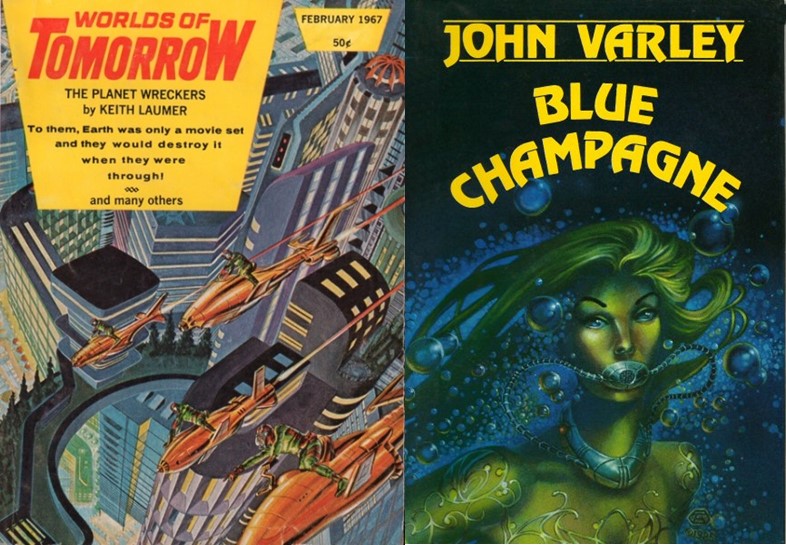 Worlds of Tomorrow 2/67 cover by Gray Morrow
Worlds of Tomorrow 2/67 cover by Gray MorrowBlue Champaign cover by Todd Cameron Hamilton
Tango Charlie and Foxtrot Romeo was originally published in the John Varley collection Blue Champagne by Dark Harvest Press in January, 1986. It won the Seiun Award in 1992.
Tango Charlie and Foxtrot Romeo was originally published in the John Varley collection Blue Champagne by Dark Harvest Press in January, 1986. It won the Seiun Award in 1992.
Like The Star Pit, Tango Charlie and Foxtrot Romeo takes place on an outpost, although it isn’t as distant as the one in Delany’s story. Instead, Varley’s focus is on a space station in orbit around Earth’s moon and the story opens with the remains of a dead dog being expelled through the station’s airlock, which is noted by a satellite which in stationed to track anything that comes out of the space station.
It turns out that the space station had been struck by a virus, Neuro X, thirty years earlier and quarantined. The expulsion of the dog is the first indication the Lunarians have that there is anything still alive on the space station. Varley story follows Anna-Louise Bach, a recruit/apprentice at the New Dresden Police Department on the moon and Charlie, a young girl who is living alone on the space station in the company of dozens of dogs.
The first half of the story deals with an assessment of the situation, Bach trying to figure out how to make contact with whoever might still be living on the space station and Charlie living her life surrounded by dogs and the station’s computer Tik-Tok, and becoming aware that someone is trying to contact her from the outside world. Eventually, contact is made and a resolution to the situation must be found. That resolution is made more difficult by information that Varley slowly reveals.
In the space of the novella, Varley creates three different societies to various degrees. The most obvious ones are the simple society that surrounds Charlie on the space station, with her interactions with the dogs, the chores that she must do, and the way she comes to terms with growing up. The second is the Lunarian society, which is clearly separate from that of Earth, beginning with fashion, but continuing to attitudes. Finally, Terrestrial culture is represented by Bach’s acquaintance Megan Galloway. Galloway is a celebrity on Earth who has a history that involves Bach. They don’t like each other, but find the can use each other to achieve their ends.
The nature of the story, following Charlie and her dogs and switching to follow Bach, means that Varley is essentially writing two intertwined stories. Charlie’s story is one of someone living on an abandoned space station, content and understanding of her world, until outside forces intrude and try to force their way of thinking on her. In many ways, Charlie is an alien race that the humans of Luna are attempting to colonize, although they wouldn’t see it that way.
The humans on Luna see themselves trying to understand the fate of a failed human colony on the Tango Charlie space station. The know that the disease that eradicated the station’s population could cause a deadly pandemic on the moon or Earth if it were released. At the same time, they have discovered that Charlie (and the dogs) have somehow managed to survive it and could offer hope for humanity if they could be studied. Unfortunately, the security system in place to make sure no contaminants escape the space station make it difficult to explore those possibilities.
As the novella progresses, Varley hints that something about Charlie may provide clues to either immortality or the impeding of aging. He also offers information about the nature of the Neuro X virus and the future of Tango Charlie, the space station upon which Charlie is resident. Some of the ideas Varley offers up in the story are seen to fruition while others are abandoned, leaving the story feeling a little unresolved, even as Varley does offer a resolution to most of his plot points. This also means that Tango Charlie and Foxtrot Romeo feels like it is part of a larger world.
 Steven H Silver is a twenty-time Hugo Award nominee and was the publisher of the Hugo-nominated fanzine Argentus as well as the editor and publisher of ISFiC Press for eight years. He has also edited books for DAW, NESFA Press, and ZNB. His most recent anthology is Alternate Peace and his novel After Hastings was published in 2020. Steven has chaired the first Midwest Construction, Windycon three times, and the SFWA Nebula Conference numerous times. He was programming chair for Chicon 2000 and Vice Chair of Chicon 7.
Steven H Silver is a twenty-time Hugo Award nominee and was the publisher of the Hugo-nominated fanzine Argentus as well as the editor and publisher of ISFiC Press for eight years. He has also edited books for DAW, NESFA Press, and ZNB. His most recent anthology is Alternate Peace and his novel After Hastings was published in 2020. Steven has chaired the first Midwest Construction, Windycon three times, and the SFWA Nebula Conference numerous times. He was programming chair for Chicon 2000 and Vice Chair of Chicon 7.
Five Gifts for the Blacksmith's Wife - Book Review by Voodoo Bride
 Five Gifts for the Blacksmith's Wifeby Lyonne Riley
Five Gifts for the Blacksmith's Wifeby Lyonne RileyWhat is it about:When her village faces a winter of starvation, Sita draws the shortest straw. Now she’s to be given to the orcs across the river in exchange for food and supplies so her family can survive. Given the chance to choose her own husband from among the eligible orc bachelors, she selects Gurrek, the reluctant blacksmith, who clearly doesn’t want her. He’s the safest option.
Gurrek has always wanted a wife of his own, but not like this. Now he’s saddled with a human woman who needs new shoes, new clothes, and can’t even speak his language. He wants nothing to do with her, and yet her sweet, strong personality draws him in closer with every passing day.
As Sita and Gurrek try to find a place to fit within each other’s lives, attraction begins to bloom between them. But Gurrek refuses to touch a woman who never wanted to be his in the first place. Can Sita break through the blacksmith’s high walls to become his true wife, mind, body, and soul?
This is a sweet, cozy, steamy orc romance that features an arranged marriage, a grumpy/sunshine dynamic, a slow burn, a virgin sexual encounter, and a winter holiday vibe. Please check the content warnings on the author's website.
What did Voodoo Bride think of it:I read a Romance with Orcs that turned out to be Urban Fantasy, and although I really liked it, I wanted to read a Fantasy Romance with Orcs. So I tracked this one down, as I love the grumpy/sunshine trope.
And this turned out to be a nice read.
I really loved Gurrek and rooted for him to get a Happily Ever After. I had a bit more trouble with Sita. At times she felt... too young. I mean: she's adult in years of course, but in her behavior she sometimes felt like a child to me. Maybe it's me and I'm getting old, but because of how she felt to me I had a hard time believing in their romance.
Still, the writing was nice, Gurrek a grumpy sweetheart, and I enjoyed the read.
I might try another one of Riley's books.
Why should you read it:Grumpy Orc!
Goth Chick News: Spirit Halloween Levels Up with Haunted: Halloween ’86 – Spirit Edition
 Haunted Halloween ’86 from Spirit Halloween
Haunted Halloween ’86 from Spirit Halloween
The only thing I like better than blowing a whole day playing video games, is playing retro video games. Of course I love movie-quality HD graphics, but little pixelated Lego-people give me a case of the warm fuzzies. I did some digging and discovered I’m far from alone. The global retro gaming market has experienced significant growth in recent years. For instance, the NES Classic Edition sold 2.3 million units in less than a year, and the SNES Classic Edition surpassed 5 million units globally. The Sega Genesis Mini also exceeded 1 million units sold worldwide in its first year. Additionally, the arcade gaming sector, closely tied to retro gaming, was valued at $19.0 billion in 2023.
But when I think of one of my favorite retailers crossing over into retro-gaming, I most definitely get the fan girl squees.
Spirit Halloween, the annual haunt-headquarters that pops up every fall in the unused strip mall space near you, has just announced Haunted: Halloween ’86 – Spirit Edition, a pixelated plunge into Halloween nostalgia brought to you by Retrotainment Games.
Set in the cursed town of Possum Hollow, Haunted: Halloween ’86 is the lovechild of old-school beat-’em-ups and platforming games. You’ll tag-team as Donny and Tami, two tweens armed with fists, feet, and some serious determination to save their town from ghoulish doom. The Spirit Edition adds an additional storyline that brings the action from 1986 into 2025. Two modern-day characters don costumes at Spirit Halloween and are magically transported to 1986 by none other than Jack the Reaper himself.
Yes indeed, it is as delightfully weird as it sounds.
For $59.99, the Spirit Edition comes with a custom NES cartridge, a retro-style game box, and a user manual (because no one remembers how to work an NES anymore).
Not rocking an NES? No problem. Haunted: Halloween ’86 is also available digitally on the Nintendo Switch, Xbox One, and Steam. These versions deliver the same 8-bit thrills without the struggle of blowing dust out of your console.
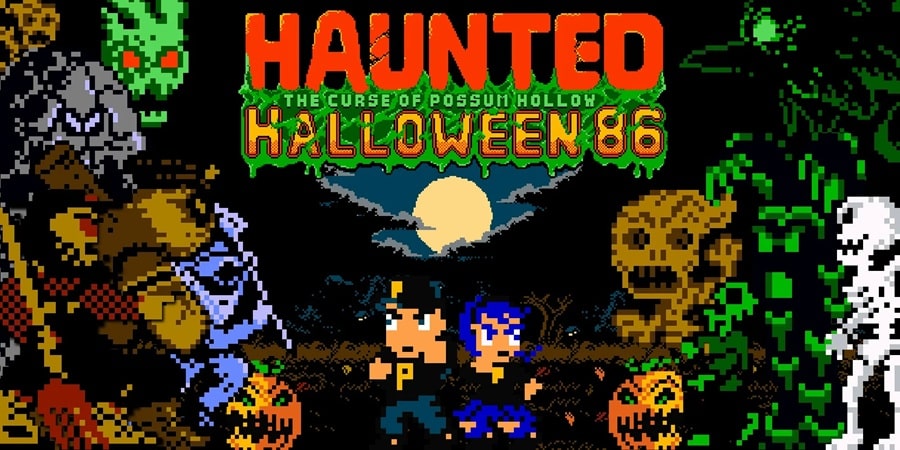 Haunted Halloween ’86
Haunted Halloween ’86
Call me naive, but I honestly believe this isn’t just a nostalgic cash grab. Retrotainment Games built Haunted: Halloween ’86 using authentic 6502 Assembly language, sticking to NES hardware specs. The game serves up modern mechanics like combo moves, upgradeable power-ups, and physics-based momentum. Add seven sprawling levels and some gnarly bosses, and you’ve got a treat worth trading all your Halloween candy for. Digital formats are coming this summer, with no specific release date announced as of now. But if you’re after the collectable cartridges those come directly from Spirit at their website and they literally sold out in a couple of hours. Restocks are coming, but no date on that yet either.
Looks like we all really love the retro experience.

Recent comments